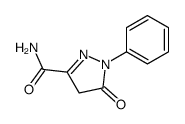65597-47-9
| Name | (+)-catechin 7-O-β-D-xyloside |
|---|---|
| Synonyms |
5-oxo-1-phenyl-4H-pyrazole-3-carboxamide
(+)-catechin 7-O-beta-D-xyloside 5-oxo-1-phenyl-4,5-dihydro-1h-pyrazole-3-carboxamide |
| Description | Catechin 7-O-beta-D-glucopyranoside is an orally active natural product found in Ulmus davidiana and Paeonia obovata. Catechin 7-O-β-D-glucopyranoside shows antioxidant and anti-inflammatory activities, and attenuates mitochondrial dysfunction. Catechin 7-O-beta-D-glucopyranoside can be used in intestinal inflammatory disease research[1][2][3]. |
|---|---|
| Related Catalog | |
| In Vitro | Catechin 7-O-β-D-glucopyranoside (10 μg/mL; 24 h) shows protective effect against Streptozotocin-induced cell damage by its antioxidant effects and the attenuation of mitochondrial dysfunction[3]. Western Blot Analysis[3] Cell Line: RINm5F rat pancreatic β-cells Concentration: 10 μg/mL Incubation Time: 24 hours Result: Increased the MnSOD level attenuated by Streptozotocin treatment. Restored the Streptozotocin-induced reduction in mitochondrial CAT level. |
| In Vivo | Catechin 7-O-β-D-glucopyranoside (intraperitoneal injection; 10 mg/kg; once) treatment shows mild protective effect against lethality induced by LPS/D-GalN[1]. Catechin 7-O-β-D-glucopyranoside (oral administration; 10 mg/kg; once daily; 7 d) treatment prevents intestinal inflammatory damages in TNBS model of rat colitis[2]. Animal Model: Mice injected with LPS/D-GalN[1] Dosage: 10 mg/kg Administration: Intraperitoneal injection; 10 mg/kg; once Result: Showed 80% LPS/DGalN-induced lethality in mice. Animal Model: Rat model of trinitrobenzenesulfonic acid (TNBS)-induced colitis [2] Dosage: 10 mg/kg Administration: Oral administration; 10 mg/kg; once daily; 7 days Result: Suppressed body weight loss and intestinal inflammatory damages in TNBS-induced colitic rats. Reduced myeloperoxidase activity and malondialdehyde level, but increased glutathione level in the TNBS colitic rats. |
| Molecular Formula | C10H9N3O2 |
|---|---|
| Molecular Weight | 203.19700 |
| Exact Mass | 203.06900 |
| PSA | 75.76000 |
| LogP | 0.46550 |
